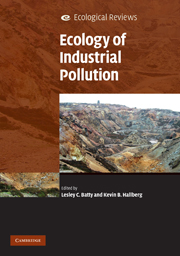Book contents
- Frontmatter
- Contents
- List of contributors
- Preface
- Acknowledgements
- 1 Consequences of living in an industrial world
- 2 Metallophytes: the unique biological resource, its ecology and conservational status in Europe, central Africa and Latin America
- 3 Lichens and industrial pollution
- 4 The impacts of metalliferous drainage on aquatic communities in streams and rivers
- 5 Impacts of emerging contaminants on the environment
- 6 Ecological monitoring and assessment of pollution in rivers
- 7 Detecting ecological effects of pollutants in the aquatic environment
- 8 With the benefit of hindsight: the utility of palaeoecology in wetland condition assessment and identification of restoration targets
- 9 An ecological risk assessment framework for assessing risks from contaminated land in England and Wales
- 10 Diversity and evolution of micro-organisms and pathways for the degradation of environmental contaminants: a case study with the s-triazine herbicides
- 11 The microbial ecology of land and water contaminated with radioactive waste: towards the development of bioremediation options for the nuclear industry
- 12 The microbial ecology of remediating industrially contaminated land: sorting out the bugs in the system
- 13 Ecological recovery in a river polluted to its sources: the River Tame in the English Midlands
- 14 Manchester Ship Canal and Salford Quays: industrial legacy and ecological restoration
- 15 Large-scale mine site restoration of Australian eucalypt forests after bauxite mining: soil management and ecosystem development
- 16 Sustaining industrial activity and ecological quality: the potential role of an ecosystem services approach
- Index
- Plate section
- References
8 - With the benefit of hindsight: the utility of palaeoecology in wetland condition assessment and identification of restoration targets
Published online by Cambridge University Press: 05 June 2012
- Frontmatter
- Contents
- List of contributors
- Preface
- Acknowledgements
- 1 Consequences of living in an industrial world
- 2 Metallophytes: the unique biological resource, its ecology and conservational status in Europe, central Africa and Latin America
- 3 Lichens and industrial pollution
- 4 The impacts of metalliferous drainage on aquatic communities in streams and rivers
- 5 Impacts of emerging contaminants on the environment
- 6 Ecological monitoring and assessment of pollution in rivers
- 7 Detecting ecological effects of pollutants in the aquatic environment
- 8 With the benefit of hindsight: the utility of palaeoecology in wetland condition assessment and identification of restoration targets
- 9 An ecological risk assessment framework for assessing risks from contaminated land in England and Wales
- 10 Diversity and evolution of micro-organisms and pathways for the degradation of environmental contaminants: a case study with the s-triazine herbicides
- 11 The microbial ecology of land and water contaminated with radioactive waste: towards the development of bioremediation options for the nuclear industry
- 12 The microbial ecology of remediating industrially contaminated land: sorting out the bugs in the system
- 13 Ecological recovery in a river polluted to its sources: the River Tame in the English Midlands
- 14 Manchester Ship Canal and Salford Quays: industrial legacy and ecological restoration
- 15 Large-scale mine site restoration of Australian eucalypt forests after bauxite mining: soil management and ecosystem development
- 16 Sustaining industrial activity and ecological quality: the potential role of an ecosystem services approach
- Index
- Plate section
- References
Summary
Introduction
Pollution sources to aquatic ecosystems can be categorised as point (or direct), those derived from identifiable sources such as sewage treatment plant outfalls, or diffuse, where the source of pollutant is more difficult to identify, such as surface erosion. In the former case, the effluent loads can be high; however, by virtue of a more clear relationship between source and impact, cause is more readily identifiable and solutions more readily encouraged or directed (Smol 2008). Diffuse pollution sources often create chronic symptoms of elevated pollution loads that are more difficult to establish experimentally and more difficult to identify spatially. In many instances, the drivers of these heightened releases of pollutants to receiving waters have a long history and originated from settlements and developments that extend beyond the memory of modern societies. The widespread and deep-in-time nature of diffuse sources of pollution, coupled with their nature as being, effectively, multiple point sources, renders the identification of the causes of diffuse pollution uncertain and so poses a greater challenge in terms of mitigation.
Diffuse pollutants are most often represented by sediments and solutes. Widespread vegetation clearance, catchment settlement, intensive tilling and cropping and excessive stocking rates of grazing animals all contribute to exposing surface soils to erosive forces that increase sediment loads to aquatic systems. This acts to increase sedimentation rates in streams and lakes and to increase the turbidity of the water itself.
- Type
- Chapter
- Information
- Ecology of Industrial Pollution , pp. 162 - 188Publisher: Cambridge University PressPrint publication year: 2010
References
- 11
- Cited by



